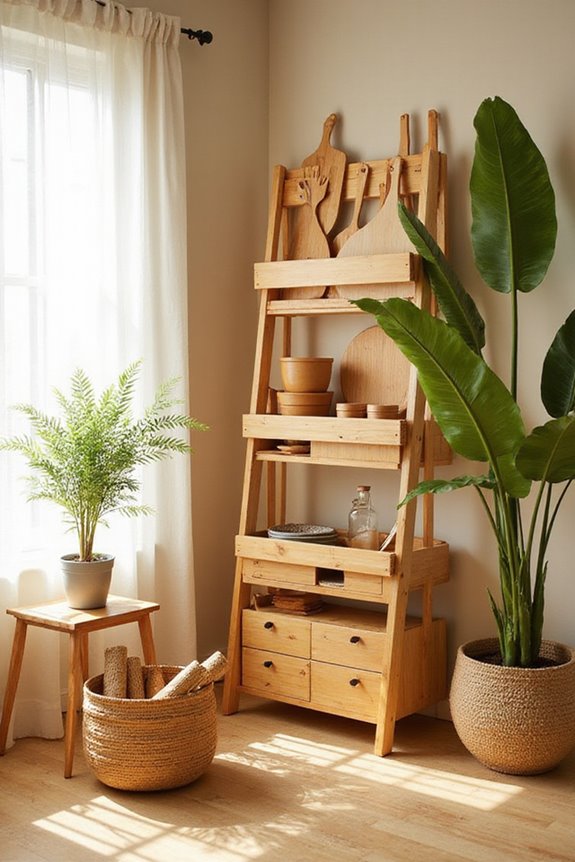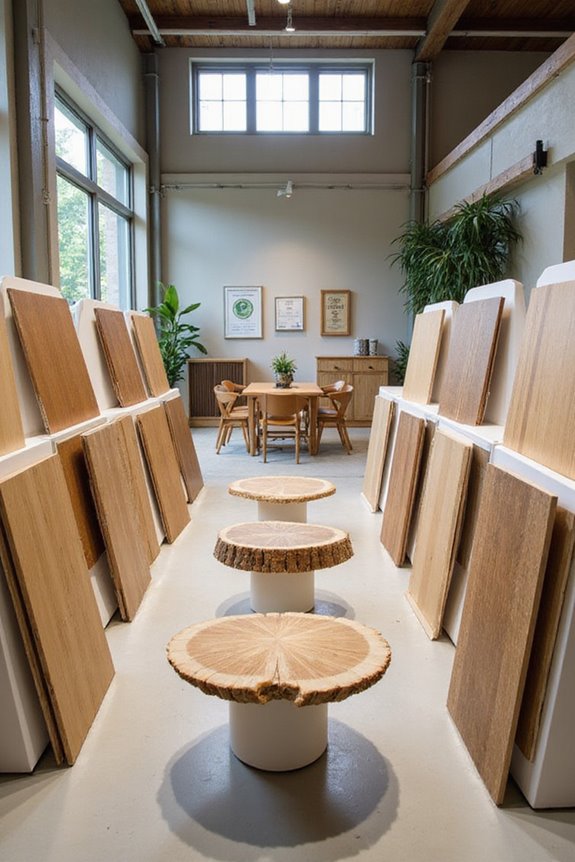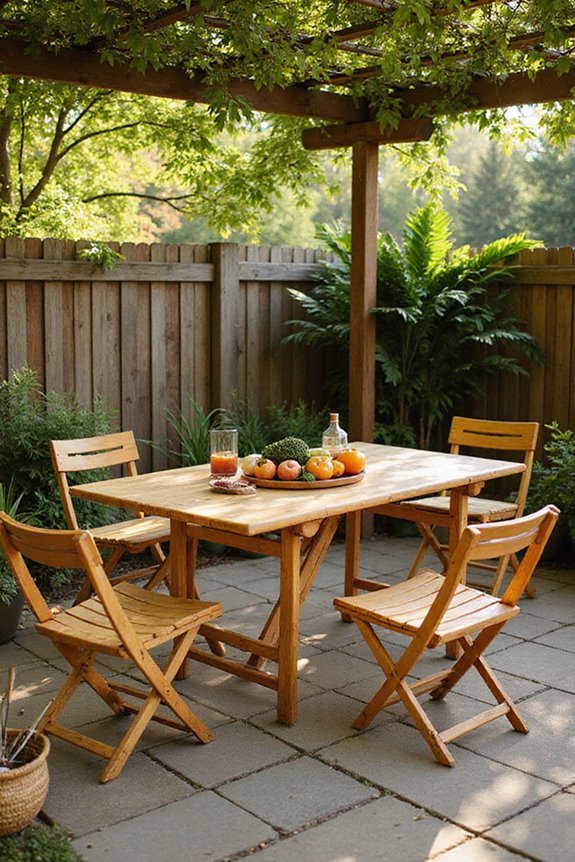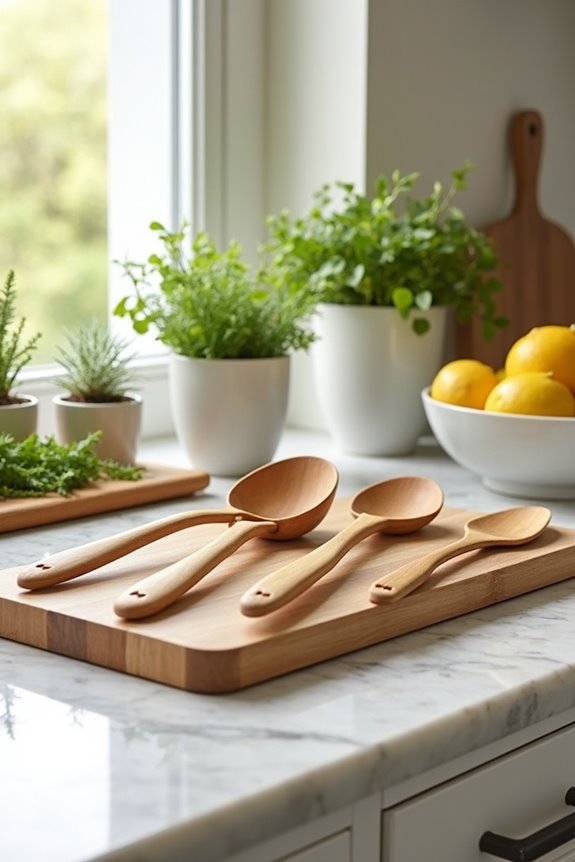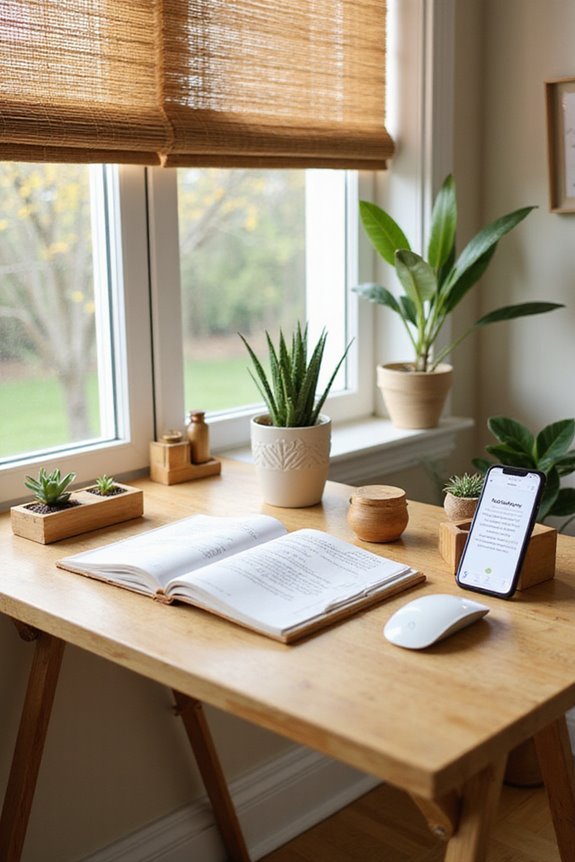To store bamboo lifestyle items properly, we must maintain ideal conditions. First, we should keep items in a temperature range of 68°F to 77°F and humidity levels between 50% and 60%. Additionally, we need to protect them from sunlight by using shaded areas and mild cleaners. It’s crucial to guarantee items are clean and completely dry before storage, using breathable packaging to allow air circulation. If we follow these guidelines, we can greatly extend the life of our bamboo products. More helpful tips await!
Key Takeaways
- Store bamboo items in a temperature range of 68°F to 77°F to prevent shrinkage or cracking.
- Maintain humidity levels between 50% and 60% to avoid mold growth.
- Use breathable packaging materials to protect bamboo while allowing moisture to escape.
- Keep bamboo products in shaded areas to protect them from UV exposure.
- Regularly inspect stored bamboo for moisture levels, physical deformities, and signs of pests.
Ideal Storage Conditions for Bamboo Items
When we think about storing bamboo items, it’s vital to create ideal conditions that preserve their quality. To achieve this, we should consider several bamboo preservation techniques. First, maintaining a storage temperature between 68°F and 77°F is essential, as this prevents bamboo from shrinking or cracking. Next, keeping humidity levels between 50% and 60% will help balance moisture content and avoid mold growth. Ideal storage locations should offer good ventilation and avoid damp areas. We should also make sure bamboo items are completely dry before storing them. Using breathable packaging materials can further protect our bamboo while allowing moisture to escape. Regular checks every few months can help us maintain these conditions and guarantee our bamboo items stay in great shape. Additionally, regular cleaning schedules can help prevent buildup that may affect the integrity of bamboo items.
Protection From Sunlight and Chemicals
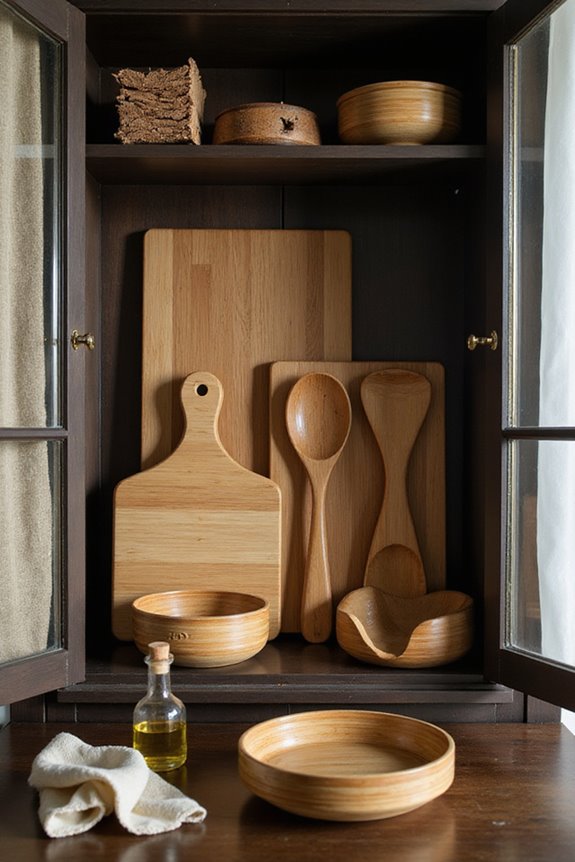
Protecting bamboo items from sunlight and chemicals is just as important as maintaining proper storage conditions. To guarantee UV protection, we should store bamboo products in shaded or indoor areas. Using window coverings can greatly reduce UV exposure. We can also rotate items to avoid uneven fading.
For chemical resistance, we need to avoid harsh cleaners. Instead, mild, pH-neutral cleaning agents are best. It’s vital to wipe spills immediately and prevent prolonged contact with chemicals. Additionally, applying a natural protective oil can enhance resistance to chemicals. Regular inspections for cracks or wear can also help maintain the condition of bamboo items.
Recommended Packaging and Storage Materials
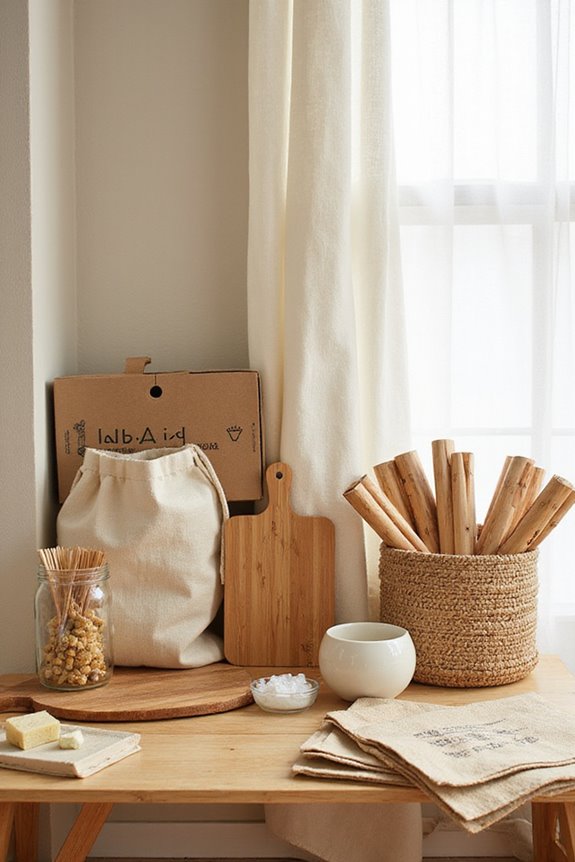
Choosing the right packaging and storage materials is essential for maintaining the quality of our bamboo items. We should prioritize moisture-proof packaging, like sealed plastic bags, to protect against humidity. This is especially important in damp environments where mold can thrive.
Using eco-friendly materials is a great way to stay aligned with bamboo’s sustainable nature. Opt for biodegradable options like recycled paper for cushioning our items. Additionally, consider using bamboo organizers that not only store but also enhance the aesthetic appeal of your kitchen.
Here are some recommendations for storage:
- Bamboo Boxes: These offer a stylish look while keeping dust and moisture at bay.
- Breathable Packaging: This balances air circulation and moisture protection.
- Natural Fiber Liners: These provide cushioning without harmful chemicals.
Cleaning and Maintenance Before Storage
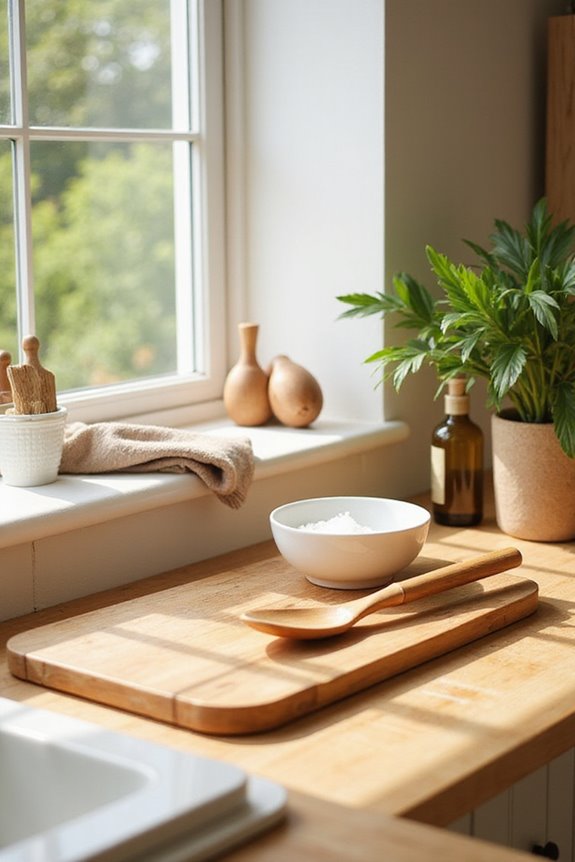
To keep our bamboo items in great shape, regular cleaning is vital before we store them. Here are some effective cleaning techniques we can use:
- Dust Surfaces: Use a soft, dry cloth to remove loose dirt regularly.
- Gentle Wiping: For deeper cleaning, dampen a cloth with lukewarm water and mild soap, avoiding soaking.
- Immediate Care: Clean kitchenware right after use to prevent stains.
Moisture management is essential. We should verify bamboo is completely dry before storage. Pat it dry with a soft cloth and allow it to air dry in a ventilated area, avoiding direct sunlight. Finally, consider applying food-safe mineral oil monthly to maintain its beauty and durability. This routine will help our bamboo items last longer, as regular oiling and conditioning significantly enhances the natural appearance of the board.
Effective Storage Solutions and Furniture

After ensuring our bamboo items are clean and dry, the next step is finding effective storage solutions that not only protect our belongings but also enhance our living spaces. Here are some great options:
- Bamboo Shelving: Adjustable shelves allow us to customize the layout for different item sizes. Their vertical design maximizes room usage, reducing clutter.
- Multi-Function Racks: These versatile racks can serve both storage and display purposes. Lightweight bamboo makes them easy to move, perfect for dynamic spaces.
- Bamboo Storage Boxes: Eco-friendly and stackable, these boxes help us organize our belongings compactly while maintaining an elegant look.
- Corner-Specific Racks: These optimize unused spaces, ensuring every corner of our home is functional. Additionally, many bamboo corner shelves feature easy assembly options, making it simple to set up and enjoy your new storage solutions.
Environmental Considerations for Storing Bamboo
When we think about storing bamboo items, understanding the environmental impact is essential. Bamboo benefits from its lower carbon footprint compared to plastics, making it a smart choice for eco-friendly practices. To maintain this advantage, we should store bamboo in dry, well-ventilated areas to avoid mold and extend its life. Proper storage conditions prevent warping, which promotes long-term usability. We can also choose natural finishes that reduce chemical pollution risks. At the end of their life, we can compost bamboo products, returning nutrients to the soil instead of adding to landfills. By following these practices, we support sustainability and embrace the natural advantages of bamboo, contributing to a healthier environment for everyone. Additionally, bamboo file cabinets offer stylish and functional storage solutions to keep your bamboo items organized and secure.
Tips for Organizing Bamboo Items
How can we effectively organize our bamboo items for both functionality and aesthetics? Here are some practical tips to enhance our storage experience.
- Bamboo Basket Organization
- Utilize various sizes of bamboo baskets to conceal clutter and maintain a natural look.
- Larger baskets are great for bulky items, while smaller ones can hold toiletries or utensils.
- Label baskets to improve item identification and retrieval.
- Choose tall bamboo shelving units to maximize vertical space in compact areas.
- Adjustable bamboo shelves allow us to customize storage for different items.
- Consider bamboo ladder shelves for stylish, accessible storage solutions.
Monitoring and Inspecting Stored Bamboo
Monitoring and inspecting stored bamboo is vital for maintaining its quality and longevity. We should establish a regular inspection frequency, such as seasonal or biannual checks, to guarantee our bamboo items stay in good condition. Moisture monitoring is essential; excessive humidity can lead to warping and mold growth.
During inspections, we must look for signs of physical deformities, like cracks or discoloration, which may indicate deterioration or contamination. It’s also important to check for pests, especially beetles and weevils. Maintaining logs of environmental conditions will help track any changes over time. By staying proactive, we can preserve our bamboo lifestyle items and enjoy them for years to come.
Long-term Care for Bamboo Lifestyle Products
Long-term care for bamboo lifestyle products is essential to guarantee their durability and functionality. To secure bamboo longevity, store items in a dry, well-ventilated area with temperatures between 68°F and 77°F. Avoid heat sources and direct sunlight, as they can cause damage.
- Use sealed, moisture-proof bags to prevent dampness.
- Apply light oil or wax for protection against environmental damage.
- Organize items vertically to save space and prevent warping.
For pest prevention, consider soaking bamboo to remove starches that attract insects. Regularly inspect your bamboo products and rotate them to guarantee even exposure to conditions. With these practices, we can enjoy the beauty and utility of bamboo for years to come.
Frequently Asked Questions
Can I Use Bamboo Items Outdoors for Storage?
Absolutely, we can use bamboo items outdoors for storage! Their durability makes them suitable, but let’s guarantee we protect them from harsh outdoor conditions to maximize their lifespan and maintain their natural beauty.
How Do I Remove Stains From Bamboo Products?
When stains mar our beautiful bamboo treasures, we must act swiftly like a gentle breeze. With effective cleaning techniques and stain removal tricks, we’ll restore their natural charm and keep them cherished in our lives.
Is It Safe to Use Bamboo in Food Storage?
We acknowledge your concerns about bamboo food safety. By following proper bamboo storage guidelines and choosing 100% bamboo or bamboo-glass products, we can confidently enjoy safe and sustainable food storage together, free from harmful chemicals.
How Often Should I Inspect Stored Bamboo Items?
We should inspect our stored bamboo items every 1-3 months, increasing frequency during humid seasons. These maintenance tips guarantee longevity, helping us cherish our bamboo treasures while preventing moisture damage and preserving their beauty together.
Can Bamboo Items Be Recycled After Use?
Absolutely, we can recycle bamboo items! Exploring bamboo recycling methods is essential, and composting bamboo products offers a sustainable solution. Together, let’s embrace these practices to reduce waste and nurture our environment.

